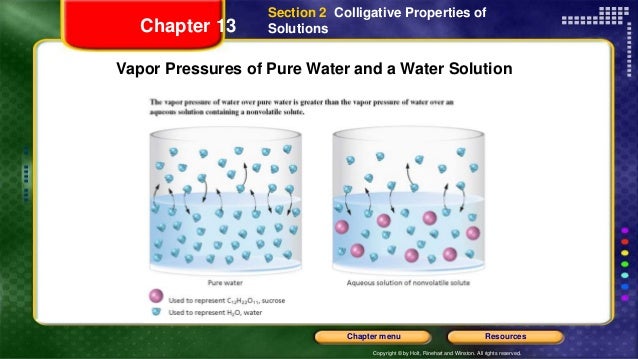Colligative Properties Of Dilute Solutions Pdf

- Colligative Properties Of Dilute Solution By Gabbar Singh Tutorials
- Colligative Properties Of Dilute Solutions
- Colligative Properties Problems And Answers
Download and Read Colligative Properties Of Dilute Solutions Colligative Properties Of Dilute Solutions. Properties of dilute solutions PDF if you have got this. DeVoe's 'Thermodynamics and Chemistry'. Save as PDF Share. From a measurement of any of the colligative properties of a dilute solution and the. How can the answer be improved?
Colligative Properties Of Dilute Solution By Gabbar Singh Tutorials
Ideal solutions and ideal gases are both simple models that ignore intermolecular interactions. Most real solutions, however, do not obey Raoult’s law precisely, just as most real gases do not obey the ideal gas law exactly. Real solutions generally deviate from Raoult’s law because the intermolecular interactions between the two components A and B differ. We can distinguish between two general kinds of behavior, depending on whether the intermolecular interactions between molecules A and B are stronger or weaker than the A–A and B–B interactions in the pure components. If the A–B interactions are stronger than the A–A and B–B interactions, each component of the solution exhibits a lower vapor pressure than expected for an ideal solution, as does the solution as a whole. The favorable A–B interactions effectively stabilize the solution compared with the vapor. This kind of behavior is called a negative deviation from Raoult’s law.
Systems stabilized by hydrogen bonding between two molecules, such as acetone and ethanol, exhibit negative deviations from Raoult’s law. Conversely, if the A–B interactions are weaker than the A–A and B–B interactions yet the entropy increase is enough to allow the solution to form, both A and B have an increased tendency to escape from the solution into the vapor phase. The result is a higher vapor pressure than expected for an ideal solution, producing a positive deviation from Raoult’s law.
In a solution of (CCl4 ) and methanol, for example, the nonpolar (CCl4 ) molecules interrupt the extensive hydrogen bonding network in methanol, and the lighter methanol molecules have weaker London dispersion forces than the heavier (CCl4 ) molecules. Consequently, solutions of (CCl4 ) and methanol exhibit positive deviations from Raoult’s law. Pi=MRT=(0.200;mol/L) left0.0821;(L⋅atm)/(K⋅mol) right (298; K)=4.89; atm B The observed osmotic pressure is only 4.15 atm, presumably due to ion pair formation.
The ratio of the observed osmotic pressure to the calculated value is 4.15 atm/4.89 atm = 0.849, which indicates that the solution contains (0.849)(4) = 3.40 particles per mole of (FeCl3 ) dissolved. Alternatively, we can calculate the observed particle concentration from the osmotic pressure of 4.15 atm: 4.15; atm=M left 0.0821;(L⋅atm)/(K⋅mol) right (298;K).
J.IIT. 1. An azeotropic mixture of two liquids boils at a lower temperature than either of them when 1) it is saturated 2) it does not deviate from Raoult’s law 3) it shows negative deviation from Raoult’s law 4) it shows positive deviation from Raoult’s law 2. A solution of a substance containing 1.05g per 100ml was found to be isotonic with 3% glucose solution.
The molecular weight of the substance is 1) 63 2) 630 3) 6.3 4) 31.5 3. In cold countries, enthylene glycol is added to water in the radiators of c ars during winters.
It results in 1) lowering boiling point 2) reducing viscosity 3) reducing specific heat 4) lowering freezing point 4. Beckmann thermometer measures 1) boiling point of the sol ution 2) freezing point of the solu tion 3) any temperature 4) elevation in boiling point or depression in freezing point 5. 2) 2 3) 1 4) 3 10.
Colligative Properties Of Dilute Solutions
The solution in which the blood cells retain their normal form are with regard to t he another 1) Isotonic 2) Hypertonic 3) Hypotonic 4) none 11. Two sol utions A and B are separated through a SPM. A has high O.P t hen B.
The osmosis will occur from 1) A to B 2) B to A 3) Both 4) none 12. When an i deal binary solution is in equilibrium with its va pour, m olar ratio of the two c omponents in the solution and in the vapour phase is 1) same 2) different 3) may or may not be same depending upon volatile nature of the two components 13. The lowering of vapour pressure of 0.1 M aqueous solution of NaCl, CuSO. Kg respectively.
A given amount of a substance when dissolved in 500g of A, it completely dimerizes and when same amount of substance is dissolved in 500g of B, the solute undergoes trimerizati on. What will be the ratio of observed lowering of freezing poin t in two cases for A and B. 1) 3: 2 2) 1: 1 3) 2: 3 4) 3: 4 21. Which inorganic precipitate s act as semipermea ble membrane 1) calcium phosphate 2) barium oxalate 3) nickel phosphate 4) copper ferrocyanide 22.

Colligative Properties Problems And Answers
By adding water to the solution of ionic compound its? 1) Concentration remains same 2) Concentration increases 3) Ionisation may increases 4) Concentration decreases 23. The process of getting fresh water from sea water is known as 1) Osmosis 2) Filtration 3) Desaltation 4) Reverse osmosis 24. Which of t he following plots does not represent the behaviour of a n ideal binary liquid solution?